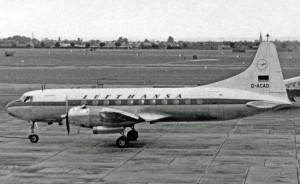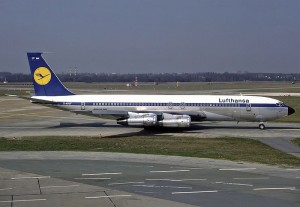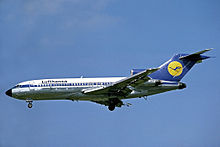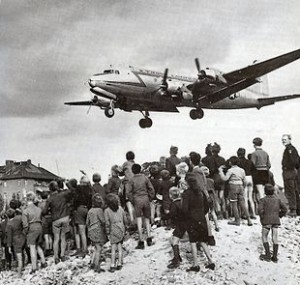Berlin Blockade

Lufthansa – Geschich
Berliners watch a C-54 Skymaster land at Tempelhof Airport, 1948
Deutsche Lufthansa AG (FWB: LHA, OTCQX: DLAKY) (German pronunciation: [ˈdɔʏt͡ʃə ˈlʊfthanza]), commonly known as Lufthansa, is the flag carrier of Germany and also the largest airline in Europe, both in terms of overall passengers carried and fleet size. It operates services to 18 domestic destinations and 197 international destinations in 78 countries across Africa, the Americas, Asia, and Europe, using a fleet of more than 280 aircraft.
Besides the actual airline named Lufthansa, Deutsche Lufthansa AG is also the parent company for several other airlines and further aviation-related branches, among the most well-known are Swiss International Air Lines and Lufthansa Technik. With over 620 aircraft, it has one of the largest passenger airline fleets in the world when combined with its subsidiaries. In 2012, the entire Lufthansa Group carried over 103 million passengers.
Lufthansa’s registered office and corporate headquarters are in Cologne. The main operations base, called Lufthansa Aviation Center (LAC), is located at Lufthansa’s primary traffic hub at Frankfurt Airport. The majority of Lufthansa’s pilots, ground staff, and flight attendants are based there. Lufthansa’s secondary hub is Munich Airport with a third, considerably smaller one maintained at Düsseldorf Airport which transfers to Germanwings so Lufthansa only operate just around 10 destinations excluded seasonal which all has been transferred to Germanwings
Lufthansa is also a founding member of Star Alliance, the world’s largest airline alliance, formed in 1997.
Having been a state-owned enterprise until 1994, the majority of Lufthansa’s shares are nowadays held by private investors (88.52%), as well as MGL Gesellschaft für Luftverkehrswerte (10.05%), Deutsche Postbank (1.03%), and Deutsche Bank (0.4%). Since 1970, Lufthansa has involved its employees in profit sharing, giving them the opportunity to choose between cash and preference shares. When Lufthansa was privatised, employees received more than 3% of its shares.
The name of the company is derived from Luft (the German word for “air”), and Hansa (a Latin term referring to the Hanseatic League).
History – 1950’s: Post-war (re-) formation
 Lufthansa’s first aircraft, a Convair 340 (type pictured), was delivered in August 1954
Lufthansa’s first aircraft, a Convair 340 (type pictured), was delivered in August 1954
Lufthansa traces its history to 1926 when Deutsche Luft Hansa A.G. (from 1933 styled as Deutsche Lufthansa) was formed in Berlin, an airline that was Germany’s flag carrier until 1945 when all services were suspended following the defeat of Germany. In an effort to create a new national airline, a company called Aktiengesellschaft für Luftverkehrsbedarf (Luftag), was founded in Cologne on 6 January 1953, with many of its staff having worked for the pre-war Lufthansa. West Germany had not yet been granted sovereignty over its airspace, so it was unknown when the new airline could become operational. Nevertheless, in 1953 Luftag placed orders for four Convair CV-340’s and four Lockheed L-1049 Super Constellations and set up a maintenance base at Hamburg Airport. On 6 August 1954, Luftag acquired the name and logo from the liquidated Deutsche Lufthansa for DM 30,000, thus continuing the tradition of a German flag carrier of that name.
On 1 April 1955 Lufthansa was granted approval to launch scheduled domestic flights, linking Hamburg, Düsseldorf, Frankfurt, Cologne, and Munich. International operations started on 15 May 1955, with flights to London, Paris, and Madrid, followed by Super Constellation flights to New York City from 1 June of that year, and across the South Atlantic from August 1956. In August 1958 fifteen Lufthansa 1049G’s and 1649’s left Germany each week to Canada and the United States, three 1049G’s a week flew to South America, three flew to Tehran and one to Baghdad.
Due to the special status of that city, Lufthansa was not allowed to fly to either part of Berlin until 1989. Originally thought to be only a temporary matter (and with intentions to move the airline’s headquarters and main base there once the political situation would change), the Division of Germany turned out to be long-lasting, which gradually led to Frankfurt Airport evolving into the major hub for Lufthansa.
East Germany attempted to establish its own airline in 1955 using the Lufthansa name, but this resulted in a legal dispute with West Germany, where the airline was already in operation. East Germany instead established Interflug as its national airline in 1963, which coincided with the East German Lufthansa being shut down.
1960’s: Jetliner introduction
 In 1960, Lufthansa joined the jet age when the Boeing 707 joined the fleet. The image shows a 707 at Hamburg Airport in 1984, shortly before the type was retired.
In 1960, Lufthansa joined the jet age when the Boeing 707 joined the fleet. The image shows a 707 at Hamburg Airport in 1984, shortly before the type was retired.
In 1958 Lufthansa ordered four Boeing 707’s and started jet flights from Frankfurt to New York City in March 1960. Boeing 720Bs were later bought to back up the 707 fleet. In February 1961 Far East routes were extended beyond Bangkok, Thailand, to Hong Kong and Tokyo. Lagos, Nigeria and Johannesburg, South Africa were added in 1962.
Lufthansa introduced the Boeing 727 in 1964 and that May began the Polar route from Frankfurt to Tokyo. In February 1965 the company ordered twenty-one Boeing 737 medium-haul jets which went into service in 1968.
Lufthansa was the first customer for the Boeing 737 and was one of only four buyers of the 737-100’s (the others were NASA, Malaysia-Singapore Airlines, and Avianca – while the NASA airframe was the first constructed, it was the last delivered and originally intended for delivery to Lufthansa). Lufthansa was the first foreign launch customer for a Boeing airliner.
1970’s–1980’s: The wide-body era
 A Lufthansa Boeing 727–100 approaching London Heathrow Airport in 1978.
A Lufthansa Boeing 727–100 approaching London Heathrow Airport in 1978.
The wide-body era for Lufthansa started with a Boeing 747 flight on April 26, 1970. It was followed by the introduction of the DC-10-30 on November 12, 1973, and the first Airbus A300 in 1976. In 1979 Lufthansa and Swissair were launch customers for the Airbus A310 with an order for twenty-five aircraft.
The company’s fleet modernisation programme for the 1990’s began on June 29, 1985 with an order for fifteen Airbus A320’s and seven Airbus A300-600s. Ten Boeing 737-300’s were ordered a few days later. All were delivered between 1987 and 1992. Lufthansa also bought Airbus A321, Airbus A340, and the Boeing 747-400.
In 1987 Lufthansa, together with Air France, Iberia, and SAS, founded Amadeus, an IT company (also known as a GDS) that would enable travel agencies to sell the founders and other airlines’ products from a single system.
Lufthansa adopted a new corporate identity in 1988. The fleet was given a new livery while cabins, city offices, and airport lounges were redesigned.


